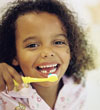 |
|
 |
 |
 |
Children's Oral Health
Overview
 Tooth decay (dental caries) affects children in the United States more than
any other chronic infectious disease. Untreated tooth decay causes pain and
infections that may lead to problems; such as eating, speaking, playing, and
learning. Tooth decay (dental caries) affects children in the United States more than
any other chronic infectious disease. Untreated tooth decay causes pain and
infections that may lead to problems; such as eating, speaking, playing, and
learning.
The good news is that tooth decay and other oral diseases that can affect
children are preventable. The combination of dental sealants and fluoride has
the potential to nearly eliminate tooth decay in school-age children.
What Parents and Caregivers Can Do
Here are some things you can do to ensure good oral health for your child:
- Encourage your children to eat regular nutritious meals and avoid
frequent between-meal snacking.
- Protect your child's teeth with fluoride.
- Use a fluoride
toothpaste. If your child is less than 7 years old, put only a
pea-sized amount on their toothbrush.
- If your drinking water is not
fluoridated,
talk to a dentist or physician about the best way to protect your
child's teeth.
- Talk to your child's dentist about
dental sealants.
They protect teeth from decay.
- If you are pregnant, get prenatal care and eat a healthy diet. The diet
should include folic acid to prevent birth defects of the brain and spinal
cord and possibly cleft lip/palate.
Check out the following Web sites for more tips on children's oral health:
Related Links
One or more documents on this Web page is available in Portable Document Format
(PDF). You will need Acrobat
Reader to view and print these documents.
* Links to non-Federal organizations are
provided solely as a service to our users. Links do not constitute an
endorsement of any organization by CDC or the Federal Government, and none
should be inferred. The CDC is not responsible for the content of the individual
organization Web pages found at this link.
|
 |